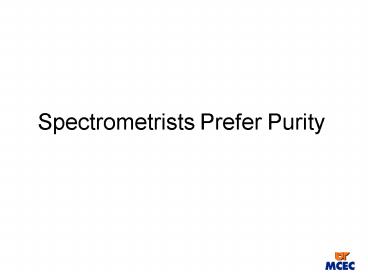Spectrometrists Prefer Purity PowerPoint PPT Presentation
1 / 22
Title: Spectrometrists Prefer Purity
1
Spectrometrists Prefer Purity
2
Process GC
6min
3
Process GC Information
- Retention time ? Identification
- Intensity ? Abundance
4
Process GC Caveats
- Retention time ? Identification (not unique)
- Intensity ? Abundance (Interferences)
5
(Process) GC/MS
6
Mass spectrum a compounds fingerprint
of acetone
J.T. Watson, Introduction to Mass Spectrometry,
Raven New York, 1986.
7
Electrospray Mass Spectrometry
Kebarle and Tang, Anal. Chem.1993, 65, 972A.
8
J.T. Watson, Introduction to Mass Spectrometry,
Raven New York, 1986.
9
Deconvolution Without Separation
J.T. Watson, Introduction to Mass Spectrometry,
Raven New York, 1986.
10
Process GC vs Process MS
- Separation based on differences in solubility.
- 20 minutes for 8-10 compounds.
- Long instrument dead bands.
- Separation based on molecular weight and
fingerprint. - Up to 40 compounds or 64 masses in
- Real time. Virtually no instrument dead bands.
11
Process Mass Spectrometry
- Well suited to processes monitored by
chromatographs (GC volatiles LC
nonvolatiles via evolving electrospray
technology) - Faster than chromatography (seconds per analysis)
with good accuracy and precision - More information than gc
- Easy to multiplex
- Robust? (Much better than in the past!)
12
Methanol
Benzene
100
100
80
80
Relative Intensity (A.U.)
60
60
Relative Intensity (A.U.)
40
40
20
20
0
0
10
20
30
40
50
60
70
80
10
20
30
40
50
60
70
80
m/z
m/z
Methanol/Benzene
100
80
60
Relative Intensity (A.U.)
40
20
0
10
20
30
40
50
60
70
80
m/z
13
Process MS Typical ExampleEthylene Oxide
streamMeans for 100 samples
- Nitrogen 53.43 0.0502
- Ethylene Oxide 2.51 0.0059
- Argon 0.37 0.0010
- Methane 0.11 0.0041
- Ethylene Chloride 0.03 0.02 ppm
- Ethane 0.35 0.0029
- CO2 5.80 0.0124
- Ethylene 29.47 0.0339
- O2 7.89 0.0125
- Methyl Chloride 1.25 0.02 ppm
14
Butene Isomers
1-Butene
Isobutene
cis-2-Butene
trans-2-Butene
15
Mass Spectra of Butene Isomers
1-Butene
Isobutene
16
1-Butene in Isobutene
Using all 19 m/zs
17
Mass Spectra of Butene Stereoisomers
18
All Four Butenes (Non-optimum parameterization)
1
0.8
r2 0.033
0.6
Calculated mole fraction
0.4
0.2
0
0
0.2
0.4
0.6
0.8
1
Actual mole fraction
19
Simultaneous AnalysisAll Four
Butenes(Optimum parameterization)
r2 0.985 0.002
20
A multi-component gas stream with a pair of C4
isomers
- Methane (CH4)
- Ethane (C2H6)
- Propane (C3H8)
- Propylene (C3H6)
- 1-Butene (C4H8)
- Isobutylene (C4H8)
21
Six Component Stream
100
r20.9983
80
60
Calculated Concentration ()
40
20
0
0
20
40
60
80
100
Actual Concentration ()
22
Conclusions Process MS
- Rapid simultaneous analysis - even of isomers -
with good accuracy and precision. - Parameterization is critical.
- Reliability has proven to be good.
- Liquids are feasible, but more challenging.
- Electrospray offers high-mass capabilities.
- Widely used for monitoring headspace (e.g.,
health monitoring in a fermentation reactor).

